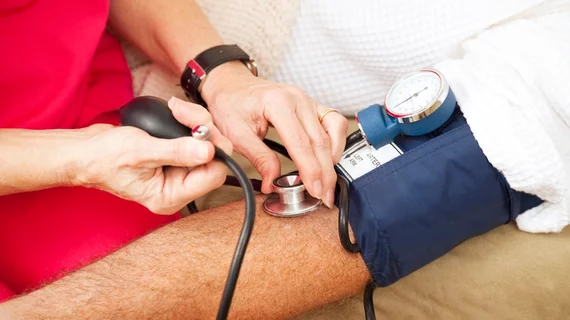Hypertensive patients from the RADIANCE-HTN SOLO trial who received renal denervation sustained a lower blood pressure through six months compared to participants randomized to a sham procedure, despite being placed on fewer antihypertensive medications during follow-up.
The updated results of the blinded, sham-controlled trial were presented at the American College of Cardiology’s scientific sessions in New Orleans and published online March 17 in Circulation.
RADIANCE-HTN SOLO randomized 74 patients to renal denervation and 72 to the sham procedure. All participants had a daytime ambulatory blood pressure between 135/85 mm Hg and 170/105 mm Hg after a four-week discontinuation of up to two blood pressure medications before randomization, and then remained off antihypertensive drugs for the first two months of follow-up.
However, between the second and fifth months, a stepwise uptitration of two blood pressure medications was enacted if a patient’s monthly home BP pressure exceeded 135/85 mm Hg.
Despite less intensive medication titration, people treated with renal denervation experienced an 18.1 mm Hg drop in systolic blood pressure (SBP) from baseline to six months, exceeding the 15.6 mm Hg decline among those undergoing the sham procedure.
Sham patients were taking an average of 1.3 BP drugs for 2.0 defined daily doses at that point, while those who underwent renal denervation were taking an average of 0.9 drugs and 1.4 daily doses. Co-principal investigator Ajay Kirtane, MD, SM, and colleagues found that after adjusting for baseline BP and the number of medications, renal denervation (RDN) was associated with a drop in SBP of 4.3 mm Hg beyond sham treatment.
“These data suggest that in patients with uncontrolled systolic-diastolic blood pressure, endovascular ultrasound RDN may be an alternative to uptitrating antihypertensive medication without increasing the risk of side effects to pharmacologic therapy,” wrote Kirtane, with Columbia University Medical Center and New York-Presbyterian Hospital, and co-authors.
Indeed, no major adverse events were reported in either group, the authors noted, adding that the gap in six-month BP may have been wider without the differences in medications taken. The proportion of patients receiving any antihypertensive drugs at six months was 65.2 percent in the RDN group and 84.5 percent in the sham group.
In subgroup analyses, patients younger than 55 showed the greatest benefit with RDN, achieving a daytime ambulatory SBP 7 mm Hg lower, on average, than with the sham procedure after adjusting for baseline values and medications. There was no significant difference in daytime ambulatory BP for patients older than 65 based on the treatment group.
Kirtane et al. said the small sample size of the study is a limitation, as well as the inability to extrapolate the results to other renal denervation catheters. ReCor Medical’s Paradise System was the RDN device used in all study participants, and ReCor Medical funded the trial.
The investigators plan to follow patients for up to three years to monitor the safety and treatment effects of each intervention.
“If safety is maintained in larger studies with longer follow-up, RDN is a promising adjunctive therapy for patients with hypertension,” they wrote.

